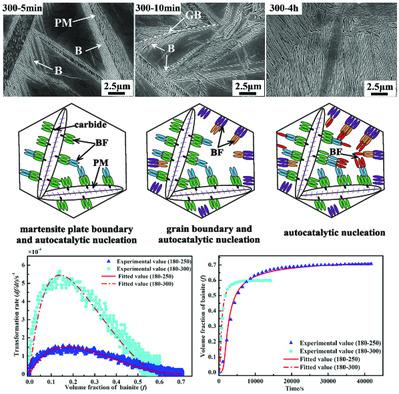当前位置:
X-MOL 学术
›
Steel Res. Int.
›
论文详情
Our official English website, www.x-mol.net, welcomes your feedback! (Note: you will need to create a separate account there.)
Microstructural Characterizations and Kinetics Model of Isothermal Bainite Formation with the Presence of Prior Martensite in High-Carbon Nanostructured Bainitic Steel
Steel Research International ( IF 2.2 ) Pub Date : 2021-04-10 , DOI: 10.1002/srin.202000708 Hui Guo 1, 2, 3 , Qiang Li 1, 2 , Jianmin Su 1, 2 , Xianying Feng 3
Steel Research International ( IF 2.2 ) Pub Date : 2021-04-10 , DOI: 10.1002/srin.202000708 Hui Guo 1, 2, 3 , Qiang Li 1, 2 , Jianmin Su 1, 2 , Xianying Feng 3
Affiliation

|
Quenching and subsequent isothermal bainite transformation (QBT) and direct isothermal transformation (DIT) procedures are performed to comparatively evaluate the impact of the introduced prior martensite on bainite transformation behaviors and microstructural characterizations in a high-carbon nanostructured bainitic steel. A thermodynamic model under a QBT process based on displacive theory is also developed to expound the bainite formation kinetics. The results indicate that the modified kinetics model, by considering austenite/martensite interface nucleation, austenite grain boundary nucleation, and autocatalytic nucleation, evolved here can be used to accurately describe the bainite formation behavior in the presence of prior martensite. A certain fraction of prior austenite/martensite interface can serve as the preferential nucleation site for the bainite transformation and assist in an acceleration of transformation rate. The bainite nucleation event initially takes place at prior martensite plate boundary in the QBT process instead of austenite grain boundary in the DIT process and subsequently continues through autocatalytic nucleation at austenite/bainite interface generated at either austenite/martensite interface or austenite/austenite interface. The introduced prior martensite slightly refines bainite sheaves and lessens the blocky retained austenite size, presenting a feasible approach to shorten the required time for producing a nanosized bainitic microstructure.
中文翻译:

高碳纳米结构贝氏体钢中存在先验马氏体的等温贝氏体形成的显微组织特征和动力学模型
执行淬火和随后的等温贝氏体转变 (QBT) 和直接等温转变 (DIT) 程序,以比较评估引入的先前马氏体对高碳纳米结构贝氏体钢中贝氏体转变行为和微观结构表征的影响。还建立了基于位移理论的 QBT 过程下的热力学模型来阐述贝氏体形成动力学。结果表明,通过考虑奥氏体/马氏体界面成核、奥氏体晶界成核和自催化成核,这里发展的修正动力学模型可用于准确描述在先前马氏体存在下贝氏体的形成行为。一定比例的原始奥氏体/马氏体界面可以作为贝氏体转变的优先形核位点,并有助于加快转变速度。贝氏体成核事件最初发生在 QBT 过程中的先前马氏体板边界而不是 DIT 过程中的奥氏体晶界,随后通过在奥氏体/马氏体界面或奥氏体/奥氏体界面生成的奥氏体/贝氏体界面的自催化成核继续。引入的原始马氏体略微细化了贝氏体滑轮并减小了块状残余奥氏体尺寸,为缩短生产纳米贝氏体微观结构所需的时间提供了一种可行的方法。贝氏体成核事件最初发生在 QBT 过程中的先前马氏体板边界而不是 DIT 过程中的奥氏体晶界,随后通过在奥氏体/马氏体界面或奥氏体/奥氏体界面生成的奥氏体/贝氏体界面的自催化成核继续。引入的原始马氏体略微细化了贝氏体滑轮并减小了块状残余奥氏体尺寸,为缩短生产纳米贝氏体微观结构所需的时间提供了一种可行的方法。贝氏体成核事件最初发生在 QBT 过程中的先前马氏体板边界而不是 DIT 过程中的奥氏体晶界,随后通过在奥氏体/马氏体界面或奥氏体/奥氏体界面生成的奥氏体/贝氏体界面的自催化成核继续。引入的原始马氏体略微细化了贝氏体滑轮并减小了块状残余奥氏体尺寸,为缩短生产纳米贝氏体微观结构所需的时间提供了一种可行的方法。
更新日期:2021-04-10
中文翻译:

高碳纳米结构贝氏体钢中存在先验马氏体的等温贝氏体形成的显微组织特征和动力学模型
执行淬火和随后的等温贝氏体转变 (QBT) 和直接等温转变 (DIT) 程序,以比较评估引入的先前马氏体对高碳纳米结构贝氏体钢中贝氏体转变行为和微观结构表征的影响。还建立了基于位移理论的 QBT 过程下的热力学模型来阐述贝氏体形成动力学。结果表明,通过考虑奥氏体/马氏体界面成核、奥氏体晶界成核和自催化成核,这里发展的修正动力学模型可用于准确描述在先前马氏体存在下贝氏体的形成行为。一定比例的原始奥氏体/马氏体界面可以作为贝氏体转变的优先形核位点,并有助于加快转变速度。贝氏体成核事件最初发生在 QBT 过程中的先前马氏体板边界而不是 DIT 过程中的奥氏体晶界,随后通过在奥氏体/马氏体界面或奥氏体/奥氏体界面生成的奥氏体/贝氏体界面的自催化成核继续。引入的原始马氏体略微细化了贝氏体滑轮并减小了块状残余奥氏体尺寸,为缩短生产纳米贝氏体微观结构所需的时间提供了一种可行的方法。贝氏体成核事件最初发生在 QBT 过程中的先前马氏体板边界而不是 DIT 过程中的奥氏体晶界,随后通过在奥氏体/马氏体界面或奥氏体/奥氏体界面生成的奥氏体/贝氏体界面的自催化成核继续。引入的原始马氏体略微细化了贝氏体滑轮并减小了块状残余奥氏体尺寸,为缩短生产纳米贝氏体微观结构所需的时间提供了一种可行的方法。贝氏体成核事件最初发生在 QBT 过程中的先前马氏体板边界而不是 DIT 过程中的奥氏体晶界,随后通过在奥氏体/马氏体界面或奥氏体/奥氏体界面生成的奥氏体/贝氏体界面的自催化成核继续。引入的原始马氏体略微细化了贝氏体滑轮并减小了块状残余奥氏体尺寸,为缩短生产纳米贝氏体微观结构所需的时间提供了一种可行的方法。



























 京公网安备 11010802027423号
京公网安备 11010802027423号